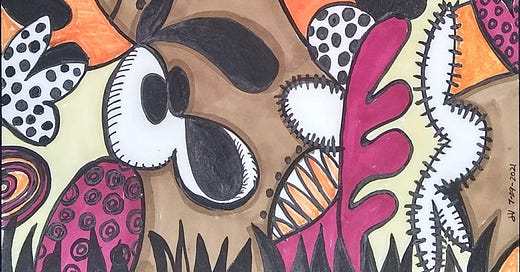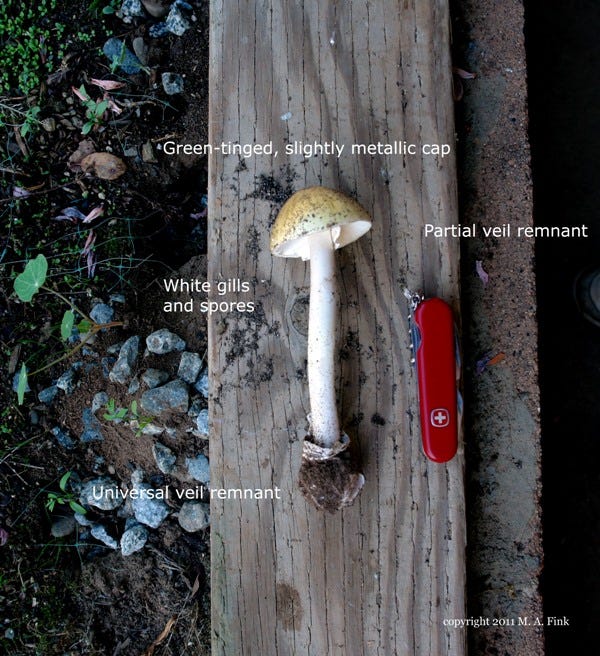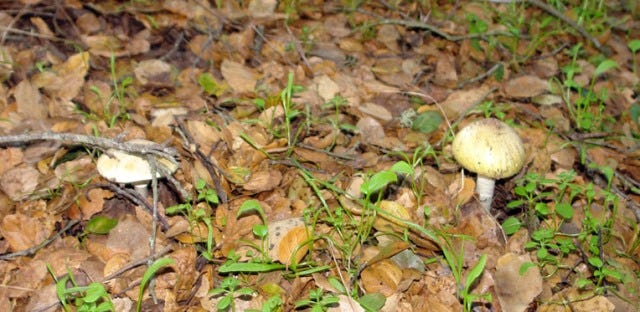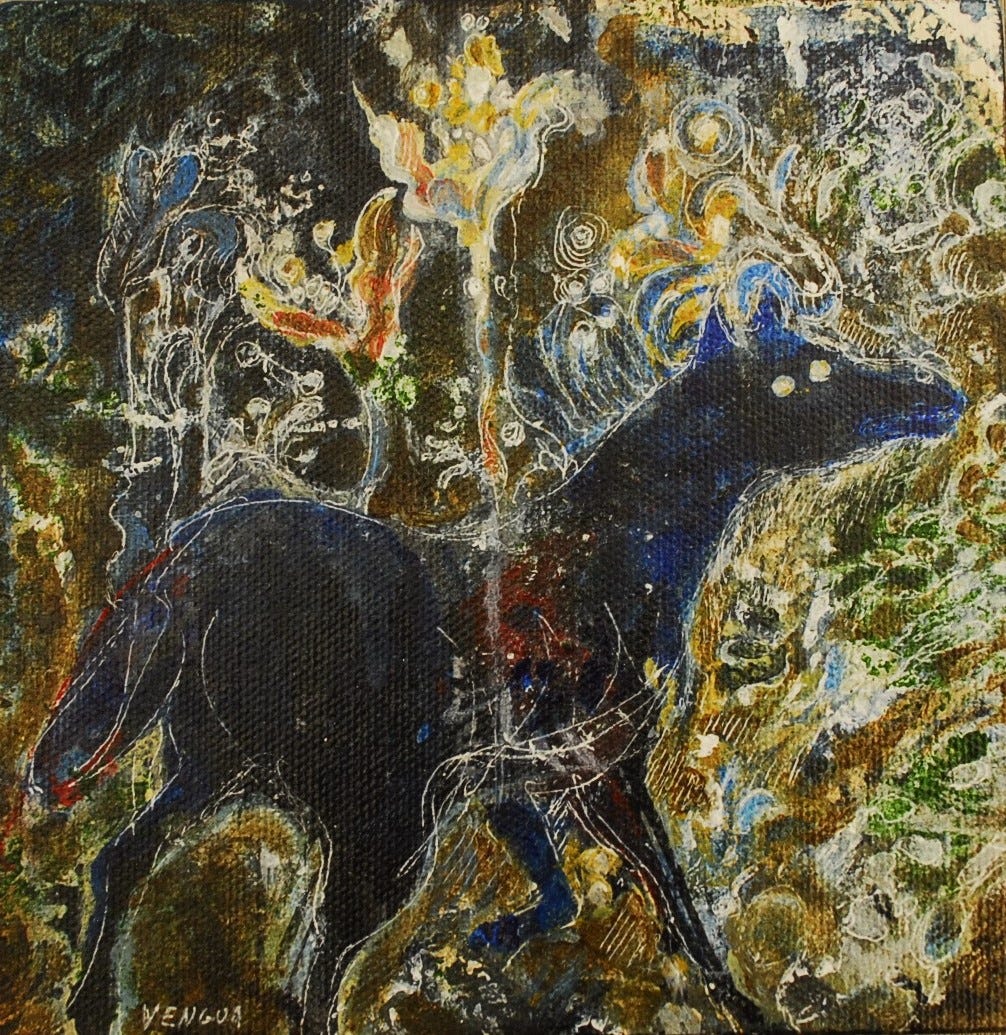Tricksters in the Garden
#125: Tricksters, Corvids, More Things that Can Kill You, Art, Dr. Leny Strobel, Julie Reynolds (Road Atlas), Maxim Peter Griffin, Dex Fernandez, Sab Palmares, Mt Stream, & The Bygones.
HERE & NOW
Well, things change. The Trickster is never far; don’t take it for granted. Currently it’s in the form of the (getting to be more frequent) raising of the rent. Saying it that way makes it sound like a capitalist ritual. This notice (which arrived on the day before Thanksgiving—great timing) always sparks a consideration of moving. To move or not to move? That is the question. And to where? And for what cost? What are the pros and cons of living in one place vs. another? I don’t have any answers at the moment. But—ridiculously high rental prices aside—my partner and I are looking around. Maybe that is why I have started thinking about my old “Local Nomad” writings. My Filipino ancestors have been archipelagic, seafaring, and to some extent nomadic, particularly on my father’s side. I’ve been in this rental for eight years, but I’m getting that nomadic feeling.
Speaking of tricksters, the crows have been visiting us often, lately. At this time of year they look as big as ravens, robust with shiny blue-black feathers. They show up with pieces of bread—perhaps foraged from the many restaurant dumpsters just a few blocks away—and use the bird bath as a dipping bowl to soften their crusty meal. I guess that’s breakfast. Later, they poke around in the garden pots for worms and bugs or they bury items they’ve scavenged; a couple days ago I uncovered a buried peanut in the shell. I put it back in the ground, hoping it might sprout one day. Several times I’ve found shiny objects (part of an earring, for example) sitting on the patio bricks. I like to think they were gifts. The other day my partner opened the front door to get the mail, and interrupted a crow in the middle of its bread-dipping ritual.
The corvid looked at him as if to say “Ahem, I’m busy here.”
“Oh, sorry,” M. said, “I’ll give you some space,” and backed into the house. So that’s our relationship with the crows, in a, uh, nutshell.
After my previous issue (#124), I thought I’d look a little more closely for plants indigenous to the area, and check out a few vacant lots where they might be trying to root themselves. I decided that the current CalFlora link was not very user-friendly, and found instead the Monterey Bay Chapter of the Native Plant Society. Earlier this year, they were giving out free packets of native California poppy seeds, a few of which I guerrilla-planted. Their site contains many good resources.
Although not specifically geared toward native plants, the local Esselen tribes website is also a resource for local indigenous knowledge.
MORE THINGS THAT CAN KILL YOU
In the previous issue it was “Poison Parsley” and hemlock. Now it’s poison mushrooms. I know what you’re thinking. Trust me; I need to get this out of my system. From “Things that Can Kill You” in Local Nomad (2011):
At the Santa Cruz Veterinary Hospital, I heard that there has recently been a rash of mushroom poisonings among pets. I worry about all the small children in this area who might pick up a mushroom and take a bite.
I live near a damp, often misty, slough area shaded by many old oak trees. It’s not unusual to encounter many different types of fungi, growing up out of the fallen oak leaves or attached to tree trunks. We’ve spotted possibly edible boletes, as well as poisonous Western Jack ‘O Lanterns (their gills glow green in the dark!), and many others, such as the Mock Meadow Mushroom, that we could only identify tentatively or not at all. It’s amazing how quickly they all pop up when the conditions are right. In any case, I’ve never wanted to take a chance on eating one.1 I’ll get my boletes and chanterelles at the market, thank you.
One mushroom that seems to grow in abundance in the Elkhorn and Royal Oaks area—and that we have been able to identify definitively—is the Amanita phalloides, or the Death Cap.2
They are utterly innocuous looking. Graceful, white, and simple in design–but absolutely deadly. Sometimes the cap has a slightly shiny green tinge. Both the spores and gills are white (See the spore color by placing the cap gill-down on a piece of dark paper. Within an hour or two, you’ll have distinctive spore prints). And you’ll often find the remnant of a thin, white “universal veil” at the bottom of the stalk.
In the wild, they are even more innocent looking, and can be confused with many other types of mushrooms, both poisonous and non-poisonous.
For more information, visit the Fungus Federation of Santa Cruz, or the North American Mycological Association.
So, not to romanticize the whole “foraging” impulse—this is just a reminder that there are things out there in the garden of nature that can kill you, or at least make you sick, unless you take the time to learn about what you are seeking.
ART/WRITING
There is a crow in this painting:
Painting commemorating the spirit of a mare who lived near my home in Elkhorn, and who perished under unfortunate circumstances. I like to think that, in spirit, she watched over her foal, who found a home with a family down the hill from us:
I’ve kept a poetry blog for “notes / drafts / bad poems” on Wordpress for a few years. It started out public, then I made it private, because I felt like it. Now it’s public again. You can see it at Okir Projects.
Also, a new issue of my archival site, Commonwealth Cafe, will be released tomorrow evening, Sunday, Nov. 25. Watch for it!
RABBIT HOLE
Dr. Leny Strobel on “Navigating decolonization” in the Future Ancestors TV (podcast).
There is hope (and possibly even home) on the road: “Road Atlas: Women Healing Trauma in the Nomad West” by Julie Reynolds in Voices of Monterey Bay.
Maxim Peter Griffin gets up at 5 a.m. to draw his “field notes” on the haunting landscape of Lincolnshire. See also an article about him in “Keep the Ink Moving” in a wonderfully named journal The Learned Pig.
You actually have to get cut, and wet, and cold, to come back with this stuff—know what I mean?”—Maxim Peter Griffin
Dex Fernandez: I’m not sure where to start with this multimedia “psychedelic” artist, but apparently the garrapata (tick) is one nexus of his art. We all have to deal with our little monsters:
SOUNDINGS
Sometimes, it’s nice to feel that your ancestors are watching over you. The Bulul is an ancestor spirit that embodies wood or stone carvings in the northern mountainous regions of the Philippines. Story and illustration by Sab Palmares,
SFX and Music by Zapslat, for Mustard World.
“Bulul” by Mt Stream.3 And maybe I’m imagining it, but there’s a consistently “kulintang” percussiveness to much of their work. I tried running the Palmares video (above) with audio on, while playing Mt Stream’s track alongside it.4 The two synced together really well!
On a different note: “Honey Pie,”5 a lovely cover of the Beatles song by Joshua Lee Turner and Allison Young (The Bygones). Recorded in England:
Thanks for reading/listening to Eulipion Outpost. As always, special thanks to my supporters for donations to my Ko-fi!
I have a LinkTree now, so you can check out my other sites all in one location.
If you haven’t already, please subscribe—still free!
Since then, I’ve gotten confident enough to eat a few easily identifiable fungi. If there’s any doubt, consult an expert, or just don’t eat it. Take a spore print instead.
We think we may have spotted one in the garden this afternoon.
“Mt Stream” does not have a bio or website. My best guess from the Spotify page is that, other than being a self-described phonk, they are probably a Filipino living in Scandinavia.
I would never have even thought of this if it hadn’t been for the MyNoise site, which encourages diy syncing of different ambient tracks together for surprising and often harmonious results.
“Honey Pie” credit: Songwriters John Lennon / Paul McCartney. Honey Pie lyrics © Songtrust Ave, Sony/ATV Music Publishing LLC









